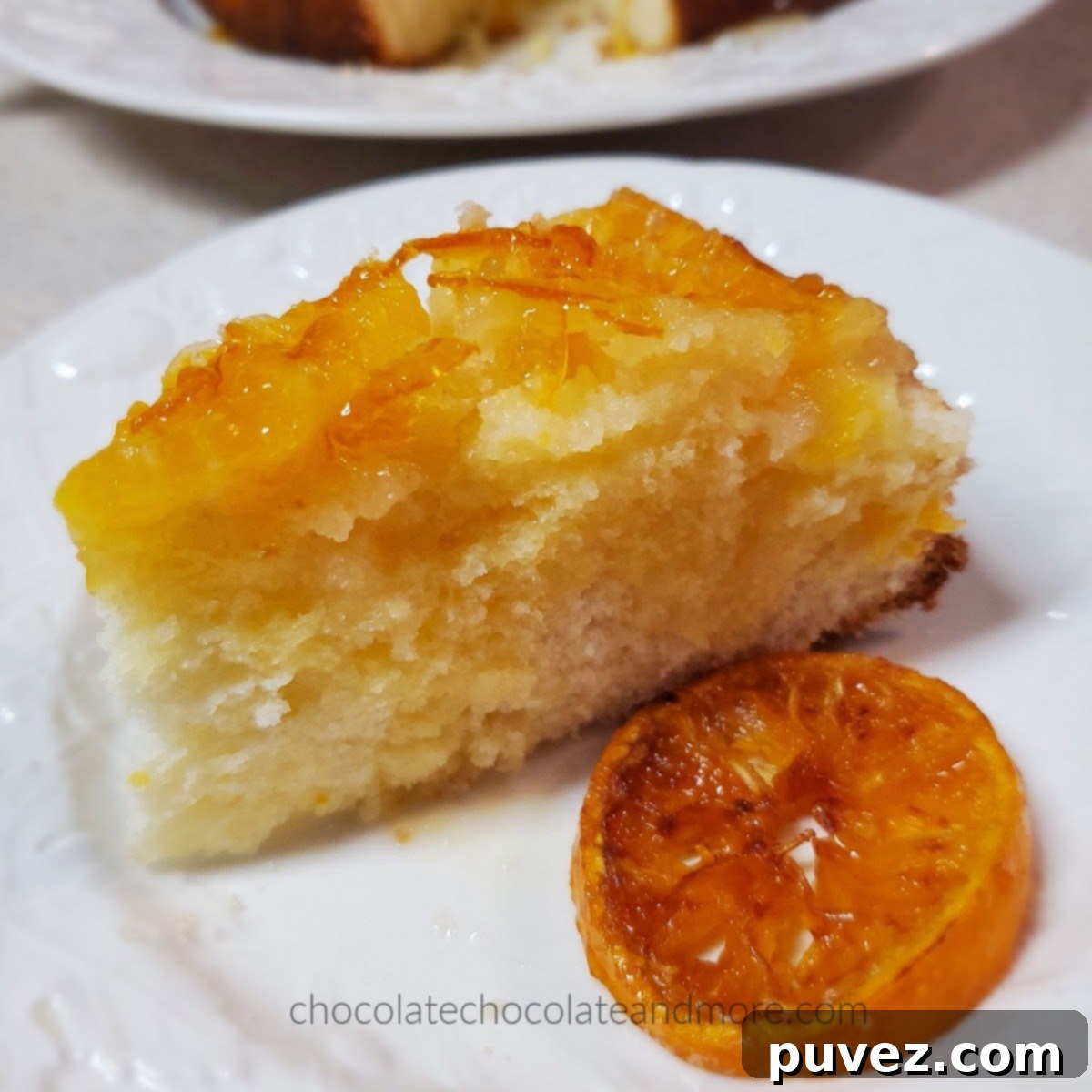Irresistibly Moist Mandarin Upside Down Cake: A Zesty Twist on a Classic Dessert
There’s something uniquely satisfying about a homemade cake, especially one that brings a burst of fresh, vibrant flavor to your palate. While the traditional pineapple upside-down cake holds a special place in many hearts, sometimes a little innovation can lead to an even more delightful experience. Enter the Mandarin Upside Down Cake – a truly moist and delicious dessert that not only brightens your day but also offers a lovely dose of Vitamin C. If you’re looking for a cake that isn’t overly sweet but delivers a powerful punch of citrus goodness, you’ve found your new favorite.
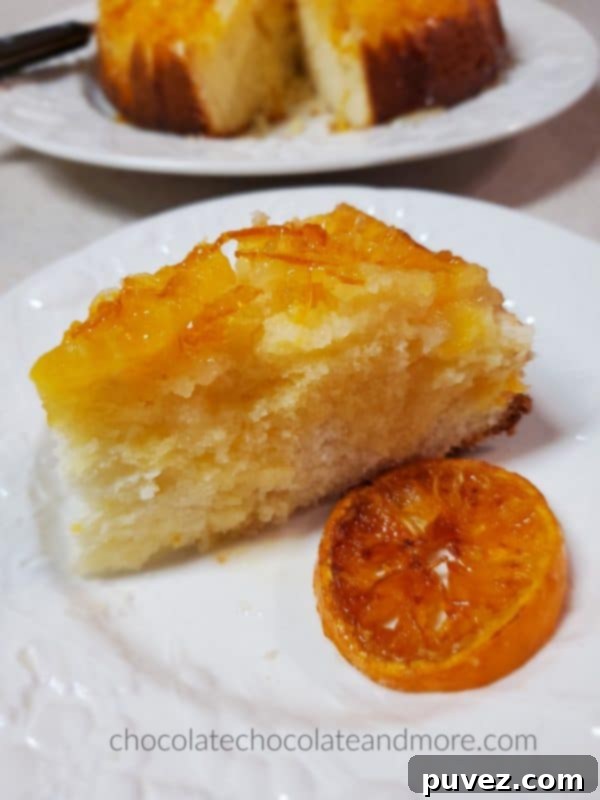
My recent baking adventure began with a simple craving for cake, but not just any cake. I wanted something light, refreshing, and free from excessive sweetness. Spotting a bag of beautiful Mandarin oranges in my kitchen, inspiration struck. Why not put a vibrant, zesty spin on the beloved upside-down cake concept? Mandarins, with their delicate sweetness and easy-to-peel nature, seemed like the perfect candidate to create a visually stunning and incredibly flavorful dessert.
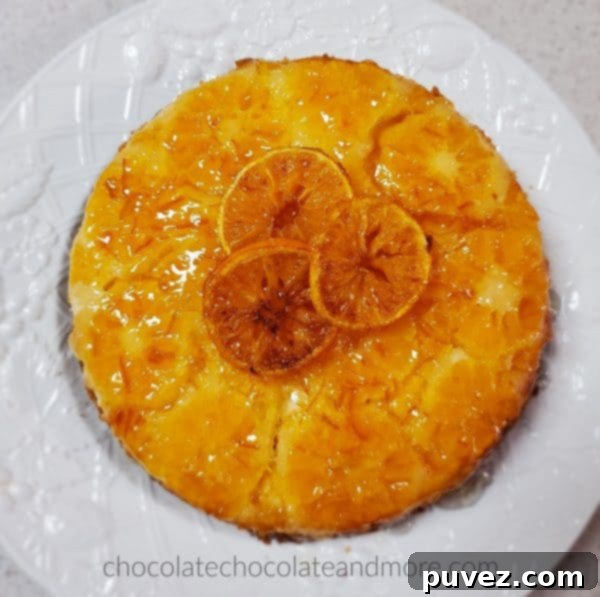
The Mandarin Magic: Choosing and Preparing Your Fruit
The beauty of an upside-down cake lies in its stunning fruit topping, which becomes the bottom of the cake once inverted. For our Mandarin Upside Down Cake, the fruit preparation is key. I embarked on a small experiment to determine the best way to arrange the mandarins for both visual appeal and optimal taste experience. I tried two distinct methods for slicing the oranges and found a clear favorite.
Method 1: Elegant Cross-Sections (The Winning Choice)
For the first cake, I carefully sliced the Mandarin oranges across their sections, creating beautiful, thin rounds. This method yielded what ultimately became my preferred presentation and texture. When arranged in the bottom of the pan, these thin slices create a delicate, almost stained-glass effect. More importantly, their thinness allows them to caramelize beautifully, absorbing the buttery, sugary syrup without becoming overly dense or watery. Each bite of cake with these cross-sections offers a harmonious blend of tender cake and soft, sweet-tart orange.
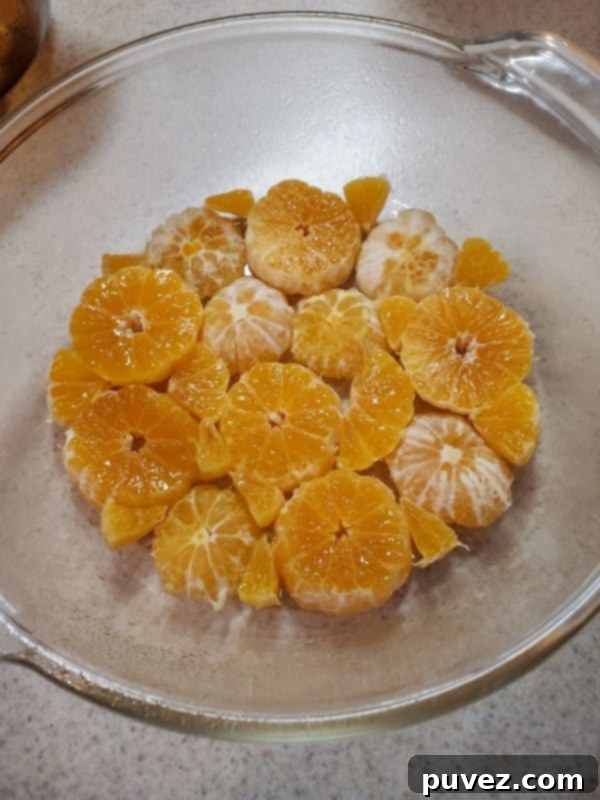
Method 2: Individual Segments (A Different Approach)
For my second attempt, I experimented by placing individual orange segments in the bottom of the dish. While this method also resulted in a tasty cake, I found the thicker segments provided a different texture. They were a bit more substantial, and while still delicious, the overall balance of fruit to cake was slightly less refined than with the thin cross-sections. Visually, the segments can create an interesting mosaic pattern, but for a truly integrated fruit experience, the slices won out.
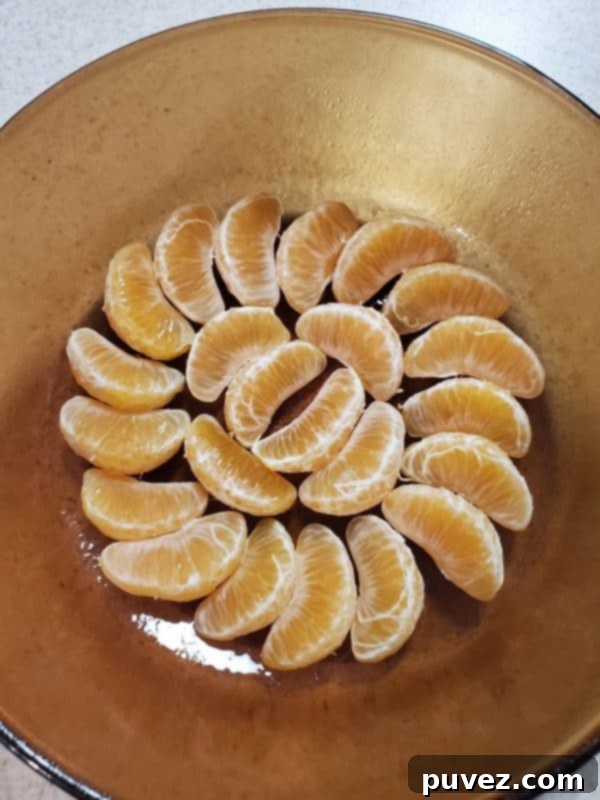
Crafting the Perfect Cake Batter
With the mandarin base prepared, the next step was to create a cake batter that would perfectly complement the bright citrus. Instead of a plain vanilla or yellow cake, I chose to infuse the batter itself with more orange flavor. I started with a basic yellow cake recipe but made a crucial alteration: replacing a portion of the liquid with fresh orange juice and adding a generous amount of orange zest. This simple tweak elevates the cake, ensuring that every forkful carries a subtle yet distinct orange aroma and taste. The zest, in particular, contributes essential oils that brighten the entire cake, making it truly sing.

Baking Tips for a Flawless Upside Down Cake
Achieving a perfect upside-down cake requires a few key considerations to ensure it releases cleanly from the pan and maintains its beautiful fruit topping. Here are some essential tips:
- Grease the Pan Generously: This might seem obvious, but it’s paramount for upside-down cakes. I learned this the hard way when one of my cakes stuck a little bit – a minor imperfection that didn’t affect the taste but could have been avoided. Be sure to grease your cake pan thoroughly with butter or a non-stick baking spray, ensuring every crevice is coated. For extra assurance, you can even dust it lightly with flour or line the bottom with parchment paper after greasing, especially if your pan isn’t non-stick.
- Don’t Overmix the Batter: Overmixing can lead to a tough cake. Mix until just combined to keep the cake tender and moist.
- Monitor Baking Time: Ovens vary, so keep an eye on your cake. It’s done when a toothpick inserted into the center comes out clean. Overbaking can dry out your beautiful cake.
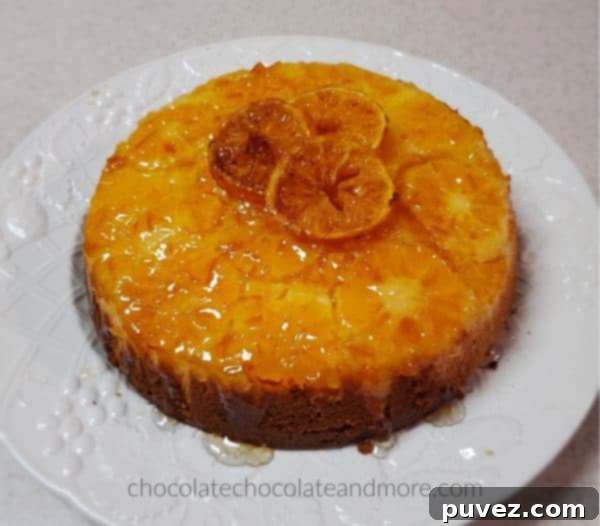
The Grand Reveal: Cooling, Inverting, and Topping
The moment of truth for any upside-down cake is the inversion. Once the cakes emerged from the oven, filling my kitchen with an intoxicating citrus aroma, I allowed them to cool for just a few minutes in the pan. This brief cooling period helps the cake set slightly, making it easier to release while still warm enough for the caramel-fruit layer to remain pliable. After a short rest, I carefully inverted each cake onto a serving plate. The sight of the glistening, caramelized mandarin slices forming a beautiful pattern on top was incredibly rewarding.
To further enhance the flavor and add an irresistible sheen, as soon as the cakes were on their plates, I generously topped them with orange marmalade. The warmth of the cake helps the marmalade spread easily, creating a thin, glossy glaze that seeps into the cake, adding another layer of moisture and a concentrated burst of orange flavor. You can add as much or as little marmalade as you desire, tailoring the sweetness and tang to your preference.
An Elegant Garnish: Candied Orange Slices
To elevate the presentation and add a sophisticated touch, I also prepared a few candied orange slices. This simple garnish is surprisingly easy to make and adds a beautiful, edible decoration. By thinly slicing oranges, coating them lightly in sugar, and gently heating them in a pan on the stovetop until they caramelize, you create stunning, translucent discs that are both decorative and delicious. They add a professional, gourmet finish to this already impressive dessert.
The Result: A Perfectly Balanced and Moist Treat
The finished cakes were everything I had hoped for and more. They were incredibly light, exceptionally moist, and boasted a perfect balance of sweet and tangy flavors. The infusion of orange zest and juice in the batter, combined with the caramelized mandarin topping and the marmalade glaze, created a harmonious symphony of citrus notes. The texture was tender and delicate, making each slice a pure delight.
Reflecting on my experiment, I definitely preferred the cake made with the cross-sections of orange. The thinner fruit provided a more even distribution of flavor and a less intrusive texture, allowing the cake itself to shine while still delivering that wonderful burst of citrus. It created a more elegant and integrated eating experience.
This Mandarin Upside Down Cake is truly a celebration of fresh, vibrant flavors. It’s a comforting yet sophisticated dessert that’s perfect for any occasion, from a casual family meal to a more formal gathering. Give this recipe a try, and prepare to impress yourself and your guests with this zesty, moist, and utterly irresistible cake!
Mandarin Upside Down Cake
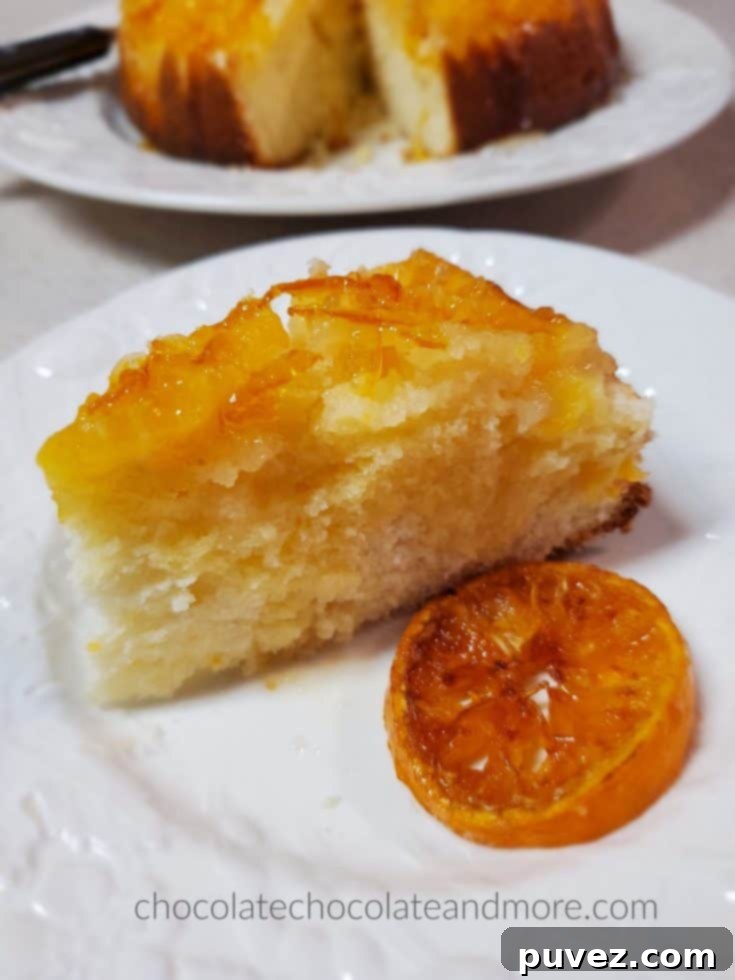
15 minutes
45 minutes
1 hour
Ingredients
- 5 Mandarin oranges
- 1 1/2 cups all purpose flour
- 1 cup sugar
- 1 1/2 teaspoon baking powder
- 1/2 cup milk
- 1/4 cup orange juice
- 1/4 cup butter
- 1 teaspoon vanilla
- 1 egg
- 1 jar orange marmalade
Instructions
- Preheat oven to 350F degrees.
- Grease a cake pan.
- Place slices of oranges in the bottom of the pan to fill it.
- Combine flour, sugar and baking powder in a mixing bowl.
- Add milk, orange juice, butter and vanilla to the dry ingredients.
- Beat on high for 2 minutes.
- Add eggs and beat for 2 more minutes.
- Pour batter on top of orange slices and bake for approximately 45 minutes until a toothpick inserted in the center comes out clean.
- Cool cake for 5 minutes before turning out onto plate.
- While the cake is still warm top it with orange marmalade. You can put as much or as little as you want.
Nutrition Information:
Yield:
8 slices
Serving Size:
1
Amount Per Serving:
Calories: 326Total Fat: 7gSaturated Fat: 4gTrans Fat: 0gUnsaturated Fat: 2gCholesterol: 40mgSodium: 159mgCarbohydrates: 63gFiber: 3gSugar: 40gProtein: 5g
Did you make this recipe?
Please leave a comment on the blog or share a photo on Instagram
Other orange recipes
Orange Butter Cranberry Cream Scones
Orange Creamsicle Truffles
Orange Creamsicles
Chocolate Orange Cashew Pastries
www.christinascucina.com
Sicilian Whole Orange Cake
iambaker.net
Easy Orange Cake {Pantry Organization}
